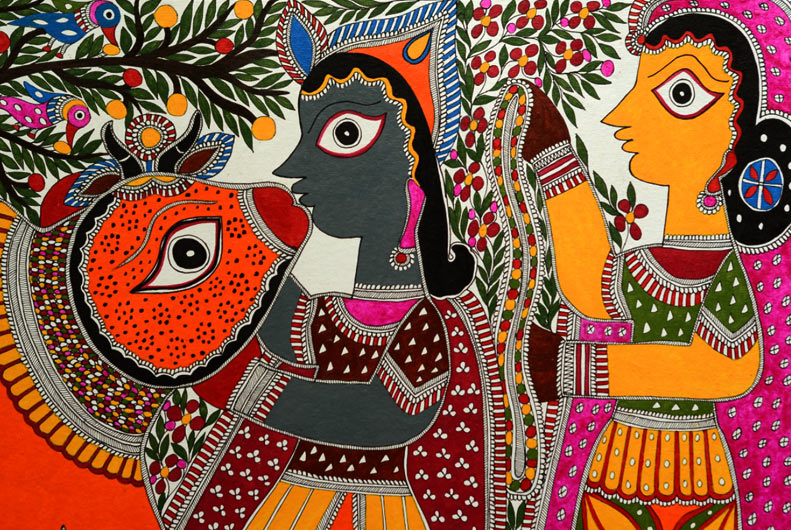Humanities 101
Feb 28, 2016
Madhubani art is a
traditional style of Hindu painting that originated in the Mithila region of
Nepal. The paintings are distinctive and a prized part of the Mithila culture.
The distinctive style is passed on through the women of a family, from mother
to daughter, and so the tradition lives on even today. Madhubani painting is a
traditional folk art with themes that have changed through the generations.
Originally painted on the mud walls of a family’s hut for decorative purposes,
Madhubani paintings have gained in popularity and are now sold commercially for
profit (Color of India). Older Madhubani paintings displayed themes of a
symbolic nature that represented fertility, rejuvenation, or prosperity. These
paintings originally served as a preparation of marriage and so themes like
fertility were appropriate. Other traditional themes include depictions of Gods
and Goddesses. The eyes of the subject are oversized and almost always shown in
side profile. The themes of today reflect current issues facing women and are
considered more socially charged than before. Painting is seen as a women’s
tradition and women of the region have taken advantage of that fact and have
begun using their paintings to bring about awareness of women’s rights in the
themes of modern Madhubani paintings (Madhubani Painting). Madhubani paintings
serve as an important cultural aspect of the region and will remain so for
generations to come.
Madhubani painting
is distinctive from other Hindu painting styles in many ways. Although it is
not known when Madhubani paintings originated, The Madhubani region has had its
own distinct regional identity for up to 2500 years. Madhubani paintings are
created on mud walls, canvas, or cloth. To apply the natural dyes and pigments
women of the region use a multitude of tools such as twigs, matchsticks and
fingers (Indian Folk Art…).
Color is an
important aspect of Madhubani paintings as almost all Madhubani paintings are
colorful if not overly so. Realist color choices are not used in Madhubani as
people are often shown in deep shades of blue or yellow. Modern Madhubani
paintings however usually depict people in neutral flesh tone shades. Animals
are also a popular subject of these paintings and are also shown in side
profile with overly large eyes and also in unusually colors. Colors are also
very highly contrasting. A color on one side of the spectrum may be used
adjacent from a color on the other side. For example blue next to yellow or red
next to green. This contrast creates a pop in the paintings that is very
eye-catching.
Another distinctive
aspect of Madhubani paintings is the use of repetition and the use of space.
Shapes are repeated over and over till fill almost all available space. Small
flower shapes, circles, squares, and lines are very repetitious. There is
almost always a decorative, repetitive border on Madhubani paintings that
further fills empty space. Although the repetition makes if difficult to distinguish
between the background, middle ground, and foreground, one could see the main
figures as the foreground and middle ground and the repetitious shapes and
flowers as the background.
There are some
other things to be mentioned about the seven elements of art that make
Madhubani paintings unique. The seven elements of art include line, shape,
color, value, form, texture and space. As mentioned above color and space are
the main factors that make Madhubani paintings unique. The value of the colors
is very uniform and there seems to be no effort to create the illusion of light
in these paintings. There are no tints or shades. The texture of the older
Madhubani paintings would be more emphasized because of the application of
color using fingers or more basic tools. Today these paintings are mass
produced prints with no texture. The application of lines are thick and
sometimes harsh. The form of these paintings is very two-dimensional and has
very little depth because of the lack of value in the colors. Objects are both
organic and geometric with the central figures being more organic and the
repetitious background being more geometric.
The principles of
design should also be mentioned when analyzing Madhubani paintings. These seven
principles include unity, rhythm, emphasis, pattern, movement, contrast and
balance. As mentioned above contrast, pattern and rhythm are important
principles of Madhubani paintings. Most paintings feature some kind of
symmetrical balance with the use of small repeating shapes in the background.
There is some movement in these paintings but with the lack of value it is not
very noticeable. There is emphasis on the main subject of the paintings because
the repeating background is easily overlooked and draws the eye to the subject
rather than the background. Unity is also seen in these paintings as even
though there is a lot of details in these paintings they are all of the similar
design and so they work together well.
Madhubani paintings are an interesting part of this local culture
and will continue to be popular for generations to come. These paintings
preserve a local culture and help spread this rich culture to all around the
world.


Works Cited
"Color Of India -
Madhubani Art." Color Of India - Madhubani Art. Web. 21 Feb. 2016.
"Madhubani
Painting." - India, Madhubani Art, S Bihar. India Tours. Web. 21 Feb.
2016.
"Indian Folk Art of
Madhubani Painting." HubPages. HubPages. Web. 21 Feb. 2016.
